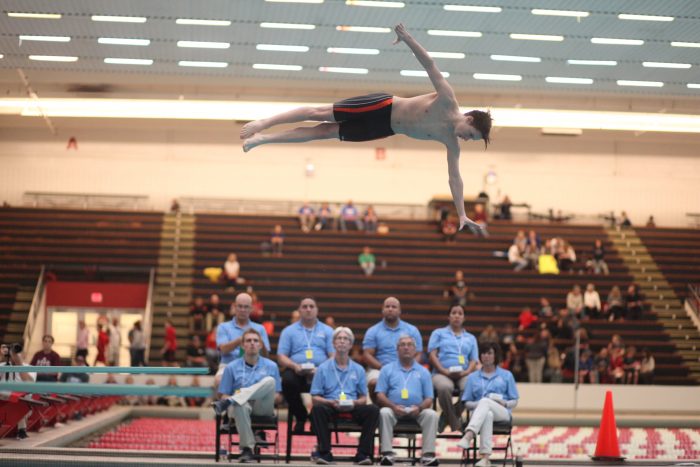Nfhs Swimming Rules Manual
2017-18 NFHS Swimming and Diving Points of. Included in the NFHS Swimming Officials Guidelines Manual. Role - The rules for NFHS swimming and diving exist to.

CIF Disclaimer Regarding the Use of Google Translate CIF has added a link to the translation feature developed by Google Translate, a third party service which the CIF has no control over. The service provides automated computer translations that are only an approximation of the websites original content. The translations should not be considered exact and only used as rough guide.
CIF does not warrant the accuracy, reliability or timeliness of any information translated by this system and will in no way accept liability for loss or harm incurred as a result to them. CIF disclaims and is not liable for any inaccuracies or problems that may be caused by the use of Google Translate feature on our website.
Nfhs Swimming Rules And Regulations

Please check with your local Section and/or State CIF offices if you have any questions.
INDIANAPOLIS, Ind. — A new penalty and signal related to unnecessary delay and a new procedure for warming up between sets that minimizes risk of injury are among the rules changes for the 2018-19 high school volleyball season. These revisions were among the rules changes recommended by the National Federation of State High School Associations (NFHS) Volleyball Rules Committee at its January 7-9 meeting in Indianapolis and subsequently approved by the NFHS Board of Directors. In Rule 10-2, after a team is charged with unnecessary delay, no further substitutions may be requested by that team until the next completed rally. This change eliminates further delay of the set by removing the option of requesting additional substitutions after a team is charged with an unnecessary delay. The committee also approved a change in Signal No.
21 regarding unnecessary delay. The new mechanics call for the official to raise the hand on the side of the offending team, beside the head with palm facing the shoulder, and hold the appropriate card on the wrist of the raised hand. “Previously, the mechanics were awkward and clumsy; this new procedure streamlines the delivery of mechanics,” said Lindsey Atkinson, NFHS director of sports and liaison to the Volleyball Rules Committee. “The new signal is a better way for the teams as well as fans to understand the penalty.” In its ongoing effort to address risk minimization, the committee approved a new rule, 11-5-3, which states that between sets, teams may warm up in their playing area; however, volleyballs may not be hit over the net. In Rule 2-4-1b, the committee clarified that no team member may assist a player during an attempt to play the ball. The wording was changed from “another player” to “team members” to clarify that no one on the team bench can assist a player who is making an attempt to play the ball.
Two rules changes were approved to clarify revisions made in the rules last year. Regarding last year’s change in the responsibilities and mechanics of the second referee during a time-out, the committee added a note to Rule 5-8-3a stating that “when multiple courts are in use, the second referee may end a time-out or interval between sets with a whistle.” Atkinson said that while the rule calls for the timer to sound the horn at 60 seconds as the defining end of a time-out, this could be confusing and distracting when multiple courts are being used. In addition, the committee added an exception to a rule (9-8-2) approved last year stating that once a replay is signaled by the first referee, no requests may be recognized until after the replay. An exception will now be allowed for an injured or ill player.
If the injured or ill player cannot continue, Rule 11-4-1b now permits the coach the option of requesting a substitution, completing a legal libero replacement or taking a time-out if the team has time-outs remaining. The final change approved by the Volleyball Rules Committee was an additional responsibility of the second referee that previously was outlined in the Volleyball Case Book and Officials Manual but not included in the rules book. 10 was added to Rule 5-5-3b stating that the second referee shall “ensure that the head coach remains in the replacement zone no closer than 6 feet to the sideline, when standing during play.” “While these changes were important to certain areas of the sport, overall the committee believed the rules of the sport are in great shape and that no major changes were necessary,” Atkinson said. “We are pleased with the continued growth of the sport, both for boys and girls.” The committee also approved several Points of Emphasis for the coming season, including Safety of Referee’s Stands, Warm-up Safety, Treatment of Line Judges and Net Fault Mechanics.
A complete listing of the volleyball rules changes will be available on the NFHS website. Click on “Activities & Sports” at the top of the home page and select “Volleyball.” According to the 2016-17 NFHS High School Athletics Participation Survey, volleyball is the second-most popular sports for girls (trailing track and field) with 444,779 participants in 15,992 schools nationwide.

In addition, there are 57,209 boys participating in the sport at 2,400 schools, and 16 states conduct state championships in boys volleyball. Release by NFHS Communications NFHS Media Contacts: Bruce Howard, Chris Boone, Lindsey Atkinson.